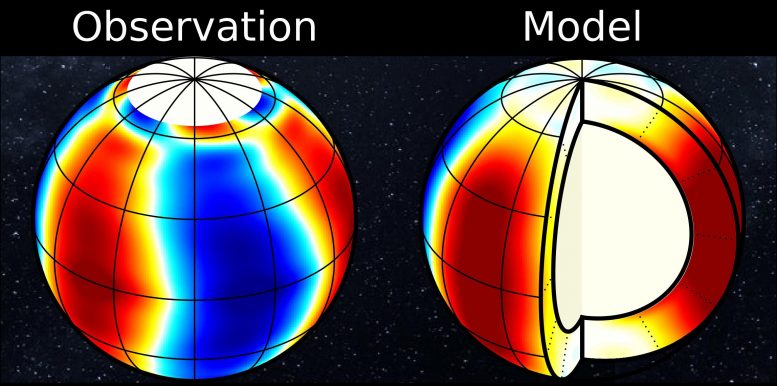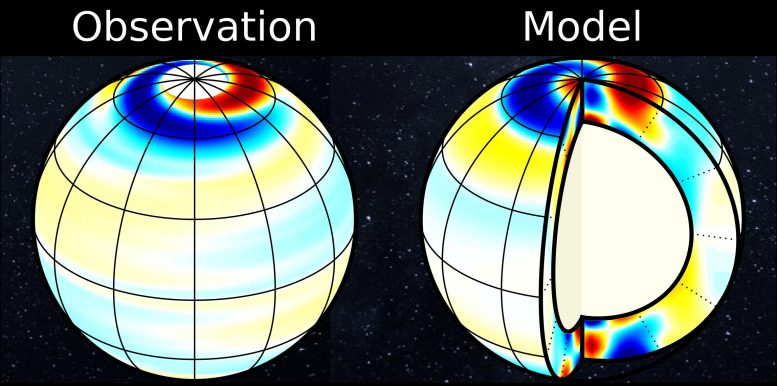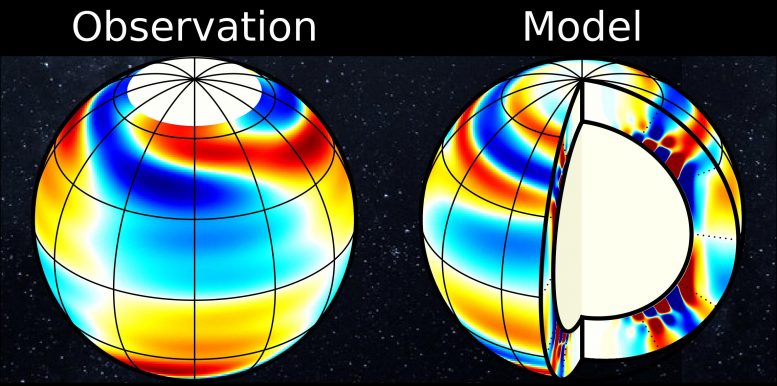
Ten years of data from NASA’s Solar Dynamics Observatory combined with numerical models reveal the deep low musical notes of the Sun.
These motions were measured by analyzing 10 years of observations from NASA’s Solar Dynamics Observatory (SDO). Using computer models, the scientists have shown that the newly discovered oscillations are resonant modes and owe their existence to the Sun’s differential rotation. The oscillations will help establish novel ways to probe the Sun’s interior and obtain information about our star’s inner structure and dynamics. The scientists describe their findings in the journal Astronomy & Astrophysics.
In the 1960s the Sun’s high musical notes were discovered: The Sun rings like a bell. Millions of modes of acoustic oscillations with short periods, near 5 minutes, are excited by convective turbulence near the solar surface and are trapped in the solar interior. These 5-minute oscillations have been observed continuously by ground-based telescopes and space observatories since the mid 1990s and have been used very successfully by helioseismologists to learn about the internal structure and dynamics of our star – just like seismologists learn about the interior of the Earth by studying earthquakes. One of the triumphs of helioseismology is to have mapped the Sun’s rotation as a function of depth and latitude (the solar differential rotation).

In addition to the 5-minute oscillations, much longer-period oscillations were predicted to exist in stars more than 40 years ago, but had not been identified on the Sun until now. “The long-period oscillations depend on the Sun’s rotation; they are not acoustic in nature”, says Laurent Gizon, lead author of the new study and director at the MPS. “Detecting the long-period oscillations of the Sun requires measurements of the horizontal motions at the Sun’s surface over many years. The continuous observations from the Helioseismic and Magnetic Imager (HMI) onboard SDO are perfect for this purpose.”
Swirling Motions Across the Sun’s Surface
The team observed many tens of modes of oscillation, each with its own oscillation period and spatial dependence. Some modes of oscillation have maximum velocity at the poles, some at mid-latitudes, and some near the equator. The modes with maximum velocity near the equator are Rossby modes, which the team had already identified in 2018. “The long-period oscillations manifest themselves as very slow swirling motions at the surface of the Sun with speeds of about 5 kilometers (3.1 miles) per hour – about how fast a person walks”, says Zhi-Chao Liang from MPS. Kiran Jain from NSO, together with B. Lekshmi and Bastian Proxauf from MPS, confirmed the results with data from the Global Oscillation Network Group (GONG), a network of six solar observatories in the USA, Australia, India, Spain, and Chile.

To identify the nature of these oscillations, the team compared the observational data to computer models. “The models allow us to look inside the Sun’s interior and determine the full three-dimensional structure of the oscillations”, explains MPS graduate student Yuto Bekki. To obtain the model oscillations, the team began with a model of the Sun’s structure and differential rotation inferred from helioseismology. In addition, the strength of the convective driving in the upper layers, and the amplitude of turbulent motions are accounted for in the model. The free oscillations of the model are found by considering small-amplitude perturbations to the solar model. The corresponding velocities at the surface are a good match to the observed oscillations and enabled the team to identify the modes.
Rotation and Interior Dynamics
“All of these new oscillations we observe on the Sun are strongly affected by the Sun’s differential rotation”, says MPS scientist Damien Fournier. The dependence of the solar rotation with latitude determines where the modes have maximum amplitudes. “The oscillations are also sensitive to properties of the Sun’s interior: in particular to the strength of the turbulent motions and the related viscosity of the solar medium, as well as to the strength of the convective driving,” says Robert Cameron from MPS. This sensitivity is strong at the base of the convection zone, about two hundred thousand kilometers beneath the solar surface. “Just like we are using acoustic oscillations to learn about the sound speed in the solar interior with helioseismology, we can use the long-period oscillations to learn about the turbulent processes”, he adds.
“The discovery of a new type of solar oscillations is very exciting because it allows us to infer properties, such as the strength of the convective driving, which ultimately control the solar dynamo”, says Laurent Gizon. The diagnostic potential of the long-period modes will be fully realized in the coming years using a new exascale computer model being developed as part of the project WHOLESUN, supported by a European Research Council 2018 Synergy Grant.
Reference: “Solar inertial modes: Observations, identification, and diagnostic promise” by Laurent Gizon, Robert H. Cameron, Yuto Bekki, Aaron C. Birch, Richard S. Bogart, Allan Sacha Brun, Cilia Damiani, Damien Fournier, Laura Hyest, Kiran Jain, B. Lekshmi, Zhi-Chao Liang and Bastian Proxauf, 6 August 2021, Astronomy & Astrophysics.
DOI: 10.1051/0004-6361/202141462
Never miss a breakthrough: Join the SciTechDaily newsletter.